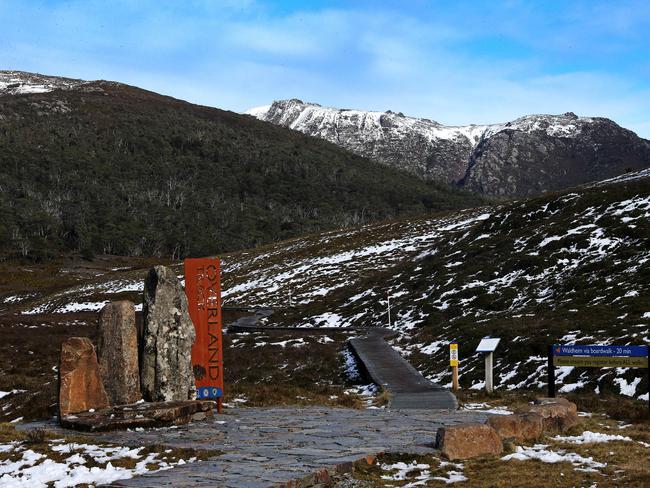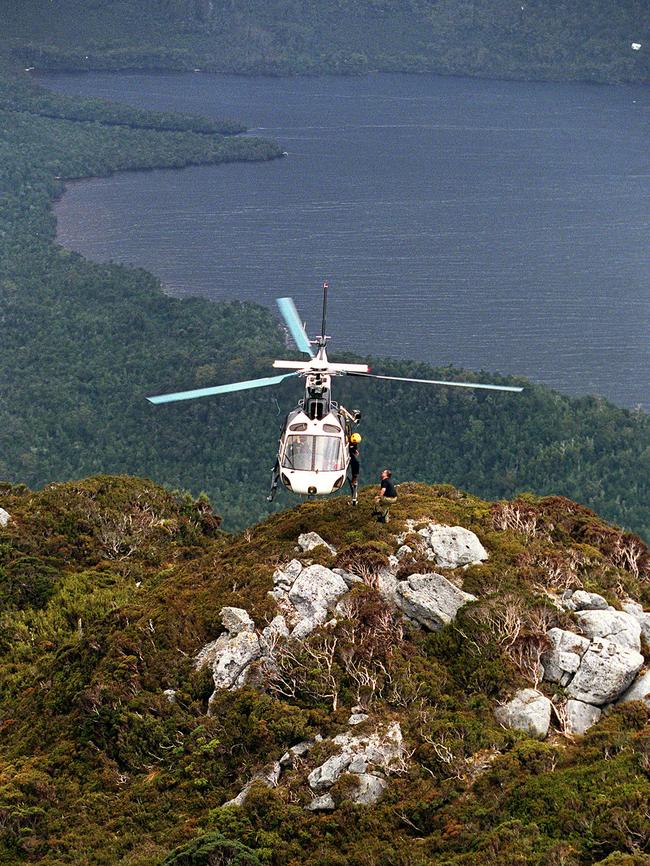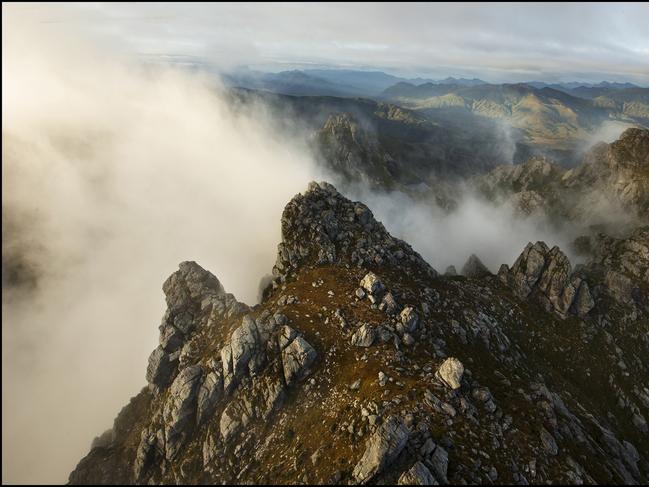Seven long-term missing people in Tasmania highlighted for National Missing Persons Week
Seven people who are missing long-term in Tasmania have been highlighted for this year’s National Missing Persons Week. INSIDE THE SEARCH >>
Police & Courts
Don't miss out on the headlines from Police & Courts. Followed categories will be added to My News.
EACH of them have loved ones who miss them – who have never forgotten their absence, not even for a day.
The stories of seven people – and their mysterious disappearances in Tasmania – have highlighted for this year’s National Missing Persons Week.
Tasmania Police has implored anyone with information about the state’s missing persons to come forward, to help locate missing persons on the island, and to “bring much-deserved answers for families and loved ones”.
National Missing Persons Week is an annual event, which runs this year from July 31 to August 6, and is aimed at resolving cases through heightened awareness and raising community recognition of the trauma that families go through.
“I urge anyone with information about a missing person to come forward,” Sergeant John Delpero, who heads up Tasmania Police’s Missing Persons Unit, said.

“Tasmania Police aim to locate missing persons and bring much deserved answers for families and loved ones, and every piece of information received will be assessed for investigation.”
Currently, there are 171 long-term missing persons in Tasmania dating back to the 1950s.
During the 2021-2022 year, 193 persons were reported missing in Tasmania – with 188 located so far.
Paul Byrne
Paul Byrne was 33 years old when he went missing from the former mining town of Rossarden on September 20, 1996.
He was last seen leaving the Rossarden Club, with no sightings of him since.
Police suspect Mr Byrne met with foul play, with a $500,000 reward on offer for information leading to a conviction.
Tasmania Police said a report was currently being prepared for the Coroner in relation to Mr Byrne’s disappearance.

Anthony Goodyer
Anthony Goodyer was last seen walking on the East Tamar Highway near George Town earlier this year – on February 4.
There have been no sightings of the 46-year-old since he was reported missing.
Police are concerned for his welfare, noting his disappearance is out of character.
Mr Goodyer was wearing dark-coloured clothes, shorts, a dark T-shirt, tan work boots and was carrying a shoulder bag.

Jason Oakley
Jason Oakley lived in Middleton, in the Huon Valley, with his partner and children.
The 36-year-old disappeared without a trace on May 9, 2007 – with no sign of him since.
A coroner has determined Mr Oakley is deceased, but has been unable to determine the exact location or manner in which he died.

Peter Gill
In August 2006, Peter Gill was at home at New Town, announcing he was going to Cornelian Bay to kick a football.
But he was never seen again.
The 39-year-old is described as 183cm tall, with a stocky build, dark hair, green eyes and a fair complexion.
A coroner found Mr Gill was deceased, but was unable to determine why he disappeared, or how he died.

Bruce Fairfax
Bushwalker and beloved retired high school teacher Bruce Fairfax was 66 when he got lost during a walk with his family on Duckhole Lake, south of Dover.
He was last seen on October 14, 2017, with a large-scale search unable to locate him.
Mr Fairfax – who was 180cm tall, slim build, fair complexion and grey hair -was described as a capable and experienced bushwalker.

Geoffrey Hay
In August 2013, 66-year-old Geoffrey Hay was last seen at his Devonport home.
The following day, there was a fire at his home, resulting in major damage, with fire investigators finding evidence an accelerant had been used.
Three years later, Mr Hay’s Suzuki 4WD was located burnt-out in bushland at Bakers Beach. Searches have been unable to locate him.
A coroner found Mr Hay was deceased, but was unable to determine how, where and when he died.

Andrew Hunt
Andrew Hunt was in Tasmania on holiday in 1995 when he disappeared.
The 33-year-old Victorian was staying with a relative at Turners Beach and had left a note saying he was going to Gunns Plains Caves and possibly Leven Canyon.
But he did not return.
A coroner found Mr Hunt was deceased, but could not determine the cause of his death.

Anyone with information about a missing persons case is urged to contact Tasmania Police on 131 444 or Crime Stoppers Tasmania at crimestopperstas.com.au or on 1800 333
000.
Information can be provided anonymously.
Charges could be laid this year in Darlene Geertsema case
POLICE were thrown off the scent when Darlene Geertsema was first reported missing back in 1978.
A series of red herrings meant for the first few months after the Devonport mother of six disappeared, investigators believed she may have died by suicide – or succumbed to drowning.
With those vital months lost, no inroads had been made into Ms Geertsema’s likely cause of death – homicide.
And so the case remained cold for some 36 years.
Then in July 2013, the case was taken over by Sergeant Felicity Boyd, then of the Devonport Criminal Investigation Branch, who was given the file to review.
With “a fresh set of eyes”, Sergeant Boyd’s tireless sleuthing ultimately led to a coronial inquest finally being held last year.
While no charges have been laid, Coroner Simon Cooper named the person he found killed Ms Geertsema.
The Mercury has not named the person of interest at Tasmania Police’s request.
Sergeant Boyd said there were some key anomalies in the case that led to that outcome, including that Ms Geertsema adored her children, would never abandon them, and planned to start a new life soon interstate.
She suspected her disappearance had primarily been treated as a missing persons case rather than a homicide because of information the person of interest had provided to police.
The first red herring was the locating of Ms Geertsema’s car, which included a picture of her children and a pair of ladies’ shoes.

The second was the person of interest reporting Ms Geertsema as missing, and thirdly, that they made claims the 30-year-old said she’d been pregnant and had cancer, Mr Cooper said in his findings.
“I continued asking myself, why would a mother of six children who had plans to move to the mainland, just disappear and permanently abandon her children?” Sergeant Boyd said.
Mr Cooper said there was no evidence Ms Geertsema had been pregnant or had cancer, or had died by suicide, moved interstate, or drowned in Devonport.
Sergeant Boyd said the evidence would be forwarded to Tasmania’s Director of Public Prosecutions, who would decide whether or not the material was strong enough to charge the person of interest – a decision that will likely be made by the end of this year.
She said it was a shame the matter took 43 years to get to an inquest – but said police back in 1978 had done everything they could with “the technology and the legislation and the policies available at the time”.

Plus, during the 1970s, issues of violence against women were treated very differently than they were today.
Lastly, DNA technology in forensics was not yet in use.
By contrast, ahead of last year’s inquest, police were able to piece together a DNA profile for Ms Geertsema by taking samples from two of her daughters and her ex-husband.
Her surviving family is still haunted by Ms Geertsema’s loss – with one of her daughters passing away the week before the coroner handed down his findings.
“It’s a tragic, tragic circumstance. I don’t know how they’ve been able to cope,” Sergeant Boyd said.
“We’re still searching for Darlene and we want to bring her home.”
Sergeant Boyd said she “absolutely” hoped charges would soon be laid – to bring closure to Ms Geertsema’s loved ones.
“We can only do the best we can do in terms of presenting all the evidence so it can be holistically evaluated, so at least I can walk away with my hand on my heart to say I’ve done all I can to support Darlene.”
Tasmania Police heroes remember their biggest search and rescues
THE year was 1995 and entrepreneur Dick Smith had funded a private search – and a fleet of helicopters – to comb through one of Tasmania’s most treacherous terrains.
Smith had been close friends with Dorothy Butler – the famed barefoot bushwalker, explorer and conservationist – whose son Wade tragically disappeared in the wilds of the aptly-named Precipitous Bluff.
One of the young men on that search, who’d just finished high school, was Callum Herbert.
Three year later, he joined Tasmania Police.
He has been searching for and rescuing lost adventurers ever since.
“The area down there is beautiful and amazing, but just inherently dangerous, as a lot of Tasmania is. The reality is you could be two metres off the track of a metre off the walking track and never be found,” Senior Constable Herbert said.
“I’ve still got the scars on my shin from falling down through the holey karst, limestone ground that’s around there.”

Prepared to respond
Mr Butler was sadly never recovered from his bushwalk, with the belief he may have fallen down a sinkhole – a vertical cave opening likely obscured by vegetation.
But the large-scale effort taken in trying to find him was just one example of the lengths taken to attempt to rescue adventurers from Tasmania’s rugged landscape.
Inspector Dave Wiss, who is in charge of the state’s Search and Rescue, said Tasmania had invested far more heavily in search and rescue capabilities than other states – due to its dense bush and rugged landscape that explorers could easily fall prey to.
He said that capacity was overlaid with help from civilian squads – like Surf Life Saving, caverneering clubs and volunteers – so when someone went missing, there would be an all-in effort to locate them.
“We say flippantly there’s only one serial killer in Tasmania and that’s Mother Nature,” he said.
“If they go in the water in wintertime, it can be a two-hour survival time.
“So we’re geared up more than some other states without the mountainous ranges and the remote wilderness.”

The science behind rescues
Inspector Wiss said one-quarter of Tasmania was inaccessible other than by aircraft, which was why the state’s search and rescue capacity was the highest in the country.
The search teams often can’t reach a person’s location on land by air, and are instead dropped in by helicopter, completing the rest of the trip by foot – such as on Cradle Mountain or in the southwest.
Inspector Wiss explained an extensive amount of science went into locating lost people in Tasmania’s wilderness and oceans – using datum buoys dropped from aircraft into bodies of water to track a person’s likely movements.
The buoys, tracked by satellites, report back data on water currents and wind patterns, which send a signal back to Marine Services in Glenorchy, highlighting a person’s likely location with a red dot on a screen.
Boats and helicopters are then instructed to patrol over search patterns, using a grid system.
“In Tassie conditions, you may only have two hours worth of survivability. And also in the water, the person isn’t going to be in the same location even after five or 10 minutes,” Inspector Wiss said.

When things don’t go as planned
It was just before Christmas last year when an experienced trail runner set out on his own to conquer Pindars Peak, in Tasmania’s treacherous southwest.
He almost never made it home.
The 38-year-old found a tiny spot on the summit in which he could get signal to phone Tasmania Police – an SOS call that ultimately saved his life.
The winds were so ferocious that a helicopter sent to rescue him went sideways and was “knocked out of the sky”.
Unable to reach the hiker by air, police sent in land crews.
“The wind blew strong enough to knock me onto the ground and roll me over four or five times. We just couldn’t get access to him,” Senior Constable Callum Herbert said.
“Eventually, after two days walking trying to get to the missing person, a weather window opened up and the helicopter landed next to him, and our search parties found him.”
A typical day in search and rescue can range from a hiker who has fallen off a cliff and broken their arm, to a grandfather with dementia who has wandered away from his son, or a young person who lost up kunanyi / Mt Wellington in a blizzard without the right clothing or equipment.
But the team resists calls for unprepared hikers to fund their own rescues.
“We’re not going to judge people on their worst day,” Inspector Wiss said.
“At the end of the day, we’re funded by the community to save the community. So we don’t get too excited with that.
“Someone could die by not sending enough resources in the first place. So it’s not something that enters our mind.”

“Immense relief”
Nothing quite beats the feeling of locating a vulnerable person – like the case of four-year-old Shayla Phillips who went missing at Stormlea earlier this year.
“Due to her age and night approaching fast, we held some real concerns,” Sergeant Bernard Peters, who has worked in search and rescue for 13 years, said.
“Children can be difficult to locate because of their size and concern for strangers. So they are difficult to find. She was playing with the dogs in the yard, and when her mum went outside, she wasn’t there.”
He said the entire search effort – supported by SES, interstate crews and helicopter search teams – experienced a wave of “immense relief” when Shayla was finally found after a three-day search, when she was heard calling “mummy”.
Inspector Wiss said the relief had been “palpable”.
“There was a feeling of elation that swept not through the ranks of both the police and the volunteers,” he said.
Senior Constable Herbert said some of his most memorable rescues had been inside caves.
“We’ve had some ripper rescues,” he said.
“There was one at Midnight Hole a few years ago, where a lady broke her leg just below the ground.
“She fell underground, which had its own complications. As you can appreciate, your standard stretcher, you just lift it up and everyone’s happy, but in a vertical cave you’ve got to bend them around corners – caves aren’t necessarily straight.”

Not all happy endings
Inspector Wiss said the job sadly did involve fatalities – which stuck in the minds of search and rescue teams long after the event.
“Probably the ones with poor outcomes can often stick with you longer than the ones with the favourable outcomes,” he said
“But at the worst we’re trying to achieve is we need closure for the families, to be able to locate their loved ones, to try and minimise their grief.”
He said one of the tragic cases that had stuck in his mind was that of 30-year-old pilot Nikita Walker, who died in a plane crash in December 2018 in the state’s southwest.
Inspector Wiss said the searches had been extensive and difficult – but with a tragic outcome.
“Her parents came in from the mainland and we met them at the airport and took them back to our police command area and explained what happened. They’re really difficult things to have to deal with, the family and letting them know the outcomes.”

Senior Constable Herbert said a case that stuck in his mind was that of 35-year-old Rachel Funari – who went missing on Bruny Island in 2011.
“We searched for days and days and it stuck out to me that she’s a single female out here having a holiday, enjoying how beautiful Tasmania is, and walked off into the bush and was never seen again,” he said.
Inspector Wiss said the missing persons cases were never closed – with search and rescue ready to conduct new searches whenever fresh information came to light.
“It will stay on our books and we will keep searching for that person whenever we get new information.”
The Lost Ones – podcast looks into the stories of missing persons
HOW does a person literally vanish from the face of the Earth?
Tasmania has long been known as a refuge, a quiet place to start a new life, as an untouched paradise cut off from the rest of the world.
But for some, that isolation has proved deadly.
Tasmania’s list of long-term missing persons is ever-growing.
Currently, 171 people are listed as missing – with cases dating back to the mid-20th century – somewhere on the island.
Today (July 31) is the start of National Missing Persons Week – an annual event designed to highlight the stories of those who’ve disappeared without a trace across the country.
The Lost Ones – a podcast by the Mercury and True Crime Australia – conducted a deep-dive into how and why people seem to go missing in Tasmania’s wilderness.
It is often believed that people have simply succumbed to the elements on the island state, with Tasmania’s rugged wilderness – its cold as well as its dangerous landscape – proving too difficult to negotiate.
But that wilderness has also provided an ideal cover for cases with more sinister elements – where a person has not truly vanished at all, but met with foul play.
To listen to the eight episodes of The Lost Ones, visit lostonespodcast.com.au, or listen via Spotify or Apple Podcasts.



